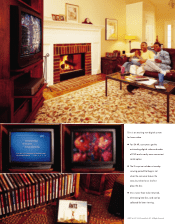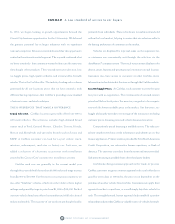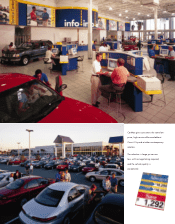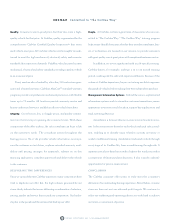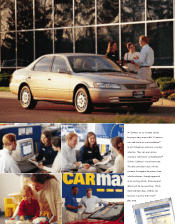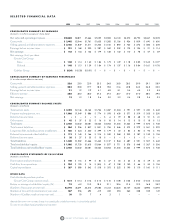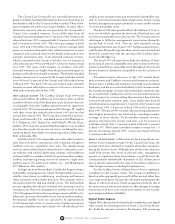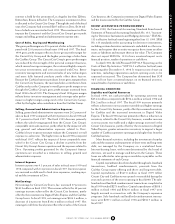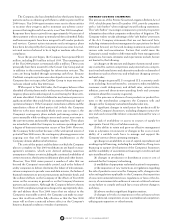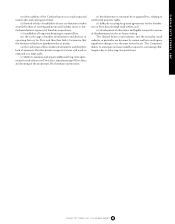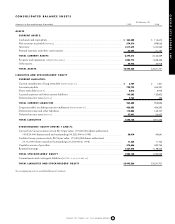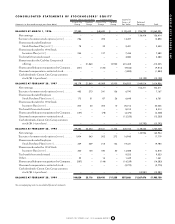CarMax 1999 Annual Report Download - page 29
Download and view the complete annual report
Please find page 29 of the 1999 CarMax annual report below. You can navigate through the pages in the report by either clicking on the pages listed below, or by using the keyword search tool below to find specific information within the annual report.
MARKET RISK
The Company manages the private-label and bankcard revolving
loan portfolios of the Circuit City Group’s finance operation and
the installment loan portfolio of the CarMax Group’s finance
operation. Portions of these portfolios are securitized and, there-
fore, are not presented on the Company’s balance sheet. Interest
rate exposure relating to these receivables represents a market risk
exposure that the Company has managed with matched funding
and interest rate swaps.
Revolving Loans
Interest rates charged on the managed private-label and bankcard
portfolios are primarily indexed to the prime rate, adjustable on a
monthly basis, with the balance at a fixed annual percentage rate.
Total principal outstanding at February 28 had the following APR
structure:
(Amounts in millions)
1999 1998
Indexed to prime rate.................................... $2,714 $2,523
Fixed APR..................................................... 243 227
Total ............................................................. $2,957 $2,750
Financing for the securitization programs is achieved primar-
ily through the issuance of public market debt, which is issued
either at floating rates based on LIBOR or at fixed rates. Certain of
the fixed-rate issuances have been swapped to LIBOR. Receivables
held by the Company for investment or sale are financed with
working capital. At February 28, financings were as follows:
(Amounts in millions)
1999 1998
Floating-rate (including synthetic
alteration) securitizations........................ $2,568 $2,211
Fixed-rate securitizations.............................. 187 290
Held by the Company:
For investment......................................... 162 204
For sale .................................................... 40 45
Total ............................................................. $2,957 $2,750
Automobile Installment Loans
Total principal outstanding for fixed-rate automobile loans at
February 28 was as follows:
(Amounts in millions)
1999 1998
Fixed APR........................................................ $592 $297
Financing for these receivables is achieved through bank con-
duit securitizations that, in turn, issue floating-rate securities.
Interest rate exposure is hedged through the use of interest rate
swaps matched to projected payoffs. Receivables held by the
Company for investment or sale are financed with working capital.
Financings at February 28 and related interest rates were as follows:
(Amounts in millions)
1999 1998
Floating-rate securitizations
synthetically altered to fixed ...................... $500 $224
Floating-rate securitizations ............................ 39 44
Held by the Company:
For investment............................................ 38 23
For sale ....................................................... 15 6
Total ................................................................ $592 $297
The Company has analyzed its interest rate exposure and has
concluded that it did not represent a material market risk at
February 28, 1999 or 1998. Because programs are in place to man-
age interest rate exposure relating to the consumer loan portfo-
lios, the Company expects to experience relatively little impact as
interest rates fluctuate in the future. The Company also has the
ability to adjust fixed-APR revolving cards and the index on float-
ing-rate cards, subject to cardholder ratification, but does not cur-
rently anticipate the need to do so.
YEAR 2000 CONVERSION
The following disclosure is a Year 2000 readiness disclosure state-
ment pursuant to the Year 2000 Readiness Disclosure Act. The
Year 2000 issue arises because many computer programs use two
digits rather than four to define the applicable year. Using two
digits to define dates after January 1, 2000, could result in a system
failure or miscalculations that cause disruption of operations
including, among other things, a temporary inability to process
transactions, process invoices or engage in similar normal business
activities. In addition to computer systems, any equipment with
embedded systems that involve date-sensitive functions are at risk
if two digits have been used rather than four. Embedded systems
are specialized microchips used to control, monitor or assist the
operation of electrical equipment.
In fiscal 1997, the Company began a Year 2000 date conver-
sion project to address necessary code changes, testing and imple-
mentation for its systems. This project includes internally
developed information technology systems, purchased and leased
software and hardware, embedded systems and electronic data
interchange transaction processing. The Company has employed
both internal and external resources to reprogram or replace and
test the software for Year 2000 modifications. The Company has
completed its remediation, forward-date testing and production
implementation efforts for its internally developed and externally
purchased systems. Replacement work and enterprise-level testing
is scheduled to be completed by approximately July 1999.
With regard to embedded systems, the Company has identi-
fied approximately 200 distinct makes and models used for envi-
ronmental controls, fire detection and monitoring, burglar
detection and monitoring, elevators, office equipment and unin-
terruptible power supplies. As of February 28, 1999, approxi-
mately 98 percent of these embedded systems are believed to be
Year 2000 compliant. The remaining 2 percent are expected to be
compliant by June 1999, except for certain low-impact embedded
systems that will be left untested because the cost of compliance
testing is believed to far exceed the risk or cost of an outage.
CIRCUIT CITY STORES, INC.
CIRCUIT CITY STORES, INC. 1999 ANNUAL REPORT 27


